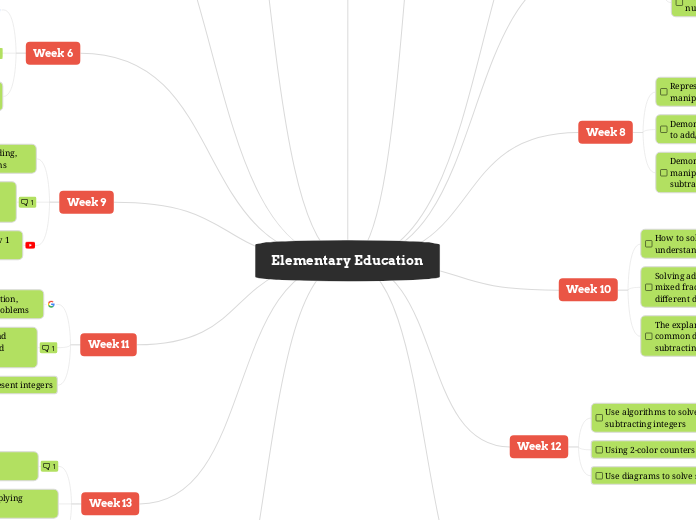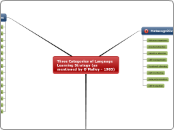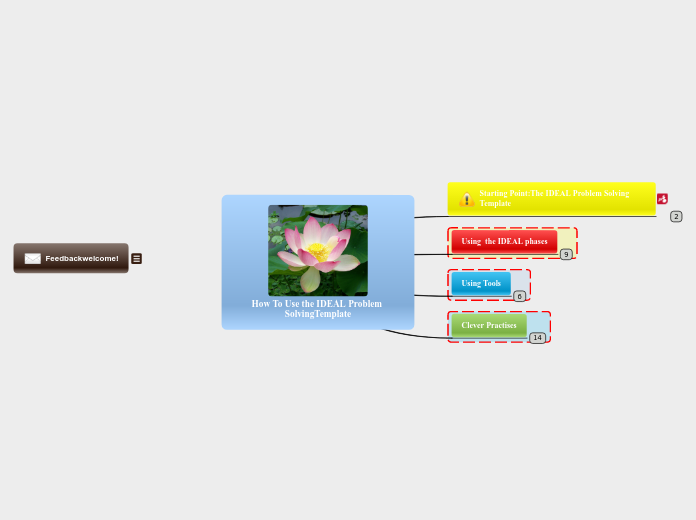Elementary Education
Week 15
Mentally calculate percents of numbers
In mathematics, a percentage is a number or ratio that can be expressed as a fraction of 100. If we have to calculate the percent of a number, divide the number by the whole and multiply by 100. Hence, the percentage means, a part per hundred. The word percent means per 100.
Calculate the percents of numbers
Demonstrate percents using a diagram
Week 13
Using algorithms to solve multiplying and dividing integers
Using diagrams to solve multiplying integers
Using 2-color counters to solve multiplication
Using two different color counters can enhance a learner's ability to see activities that are happening in their minds. Each counter represents a positive one (+1). These are used to perform the four basic operations (addition, subtraction, multiplication, and division) on the integers (positive and negative whole numbers and zero).
Week 11
Use 2-color counters to represent integers
Learn how how to add, subtract and multiply integers using concrete and pictorial representations
Adding two positive integers results in positive integers, whereas adding two negative integers will result in the sum with a negative sign. But, the addition of two different signed integers will result in subtraction only and the sign of the result will be the same as the larger number.
Use 2-color counters to solve Addition, Subtraction, and Multiplication Problems
Week 9
Determine when it is necessary to draw 1 diagram, 2 diagrams, or 3 diagrams
Demonstrate how to add, subtract and multiply fractions using a pictorial representation
Before adding or subtracting fractions with different denominators, the fractions must be written using a common denominator. The common denominator will be a multiple of the two denominators. Then, rewrite the fractions using the common denominator, and add or subtract.
How to draw representations of adding, subtracting and multiplying fractions
Week 6
Determine which fraction is larger by using reasoning skills versus an algorithm
Describe why students will need to find common denominators for certain problems but not for other problems
The most important thing you can support your child with is their understanding that a fraction is a part of a whole, or a whole is several parts. A unit fraction is an equal part of a whole. If they can grasp this, they can move forward.
Identify what the numerator and the denominator mean in meaningful context
Week 3
Alternative algorithms for subtraction
Demonstrate basic subtraction problems using manipulatives and pictorial representations
Alternative algorithms for addition
When determining which alternate algorithm to use for addition, know that the left-to-right solution is efficient compared to the expanded form, which is inefficient.
Week 2
How to use alternative algorithms for addition
Showing Addition
When showing addition using the block strategy to help, smaller numbers can easily be picked up. Using the showing method with something like this,
22five + 14five can be confusing at first but with time you know that you need 2 longs and 2 ones for 22, and 1 long and 4 ones for 14. A total of 3 longs and 6 ones, 5 of the ones can be used to create an extra long. Ending with 4 longs and 1 one.
Building Addition Base Ten Blocks
Week 1
Earliest stages of number senses and problem solving process
In understanding the problem, number sense comes into play as we analyze the numbers involved, their relationships, and any patterns or structures they may exhibit.
As we move through the subsequent steps of devising and carrying out a plan, number sense continues to guide us in making informed decisions.
At the start of this class, we reviewed the syllabus, supplies, and books needed
Subtopic
Ploya's problems, 4 step method
Week 14
Determine how many groups are in an expression and correctly utilize the order of operations
The order of operations are the rules that tell us the sequence in which we should solve an expression with multiple operations. The order is PEMDAS: Parentheses, Exponents, Multiplication, and Division (from left to right), Addition and Subtraction (from left to right)
How to calculate negative numbers that are being squared
The order of operations for solving expressions
Week 12
Use diagrams to solve subtracting integers
Using 2-color counters to solve subtraction
Use algorithms to solve adding and subtracting integers
Adding and subtracting with integers involves combining positive and negative numbers. When adding integers with the same sign, you add their absolute values and keep the sign. When adding integers with different signs, you subtract their absolute values and use the sign of the larger number. When subtracting integers, it's like adding the opposite. Always remember to pay attention to the signs and keep track of them throughout the operation.
Week 10
The explanation as to why we need to find common denominators when adding and subtracting but not multiplying or dividing
Solving add/sub/multiply problems with mixed fractions, same denominator and different denominator
How to solve fractions using reasoning and understanding
- Step 1: Find the LCM of the two denominators.
- Step 2: Convert both the fractions into like fractions by making the denominators the same.
- Step 3: Subtract the numerators. ...
- Step 4: Convert the resultant fraction to its simplest form if the GCF of the numerator and denominator is not 1.
Week 8
Demonstrate how to use Fraction manipulatives to solve additions, subtraction and multiplication problems
To multiply fractions, multiply the numerators and multiply the denominators. To add or subtract fractions, add or subtract the numerators and place the result over the common denominator.
Demonstrating how to use manipulatives to add/sub/multiply fractions
Representing fractions using different manipulatives
Week 7
How to demonstrate the meaning of the numerator and denominator
The numerator and denominator of a fraction are the top and bottom numbers of a fraction. The numerator of a fraction is the number of parts of the whole; it's the top number of a fraction. The denominator of a fraction is the number of equal parts the whole is divided into; it's the bottom number of a fraction.
Use manipulatives to demonstrate how to find equivalent fractions.
Use manipulatives to demonstrate the meaning of fractions.
Week 5
How to find prime factorization and how discover how it is used
- Start with 4 blocks. Share them into 2 equal groups.
- Start with 10 blocks. Share them into 2 equal groups.
- Start with 6 blocks. Share them into 3 equal groups.
How to demonstrate division problems using base ten blocks, pictorial representations, and alternative algorithms
The skill of looking at a number and determining its divisibility given a set of numbers
Week 4
Demonstrate strategies to increase student automaticity of multiplication facts
Not only did this lesson teach me to teach different ways so students can understand, but also the fact that anyone no matter how old can be confused by something until it is shown a different way. I was struggling to grasp any information at the beginning of this module but after seeing the many examples provided I was able to see a different way of solving which came across easier to me.
Use alternative algorithms to multiply multi digit multiplication
Use base ten blocks to build 1 and 2-digit multiplication and draw diagrams









